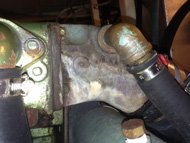Even though both engines run at normal temps, the one with the burnt exhaust elbow might be getting plugged with scale inside. This can cause a blocked flow path and localized overheating which may cause the discoloration you are seeing.
Another cause may just be low raw water flow due to a bad impeller or worn raw water pump, so check that first. If you can get a bucket under the exhaust outlet, measure how long it takes to fill on the port and starboard side at idle and compare. Any significant difference is either the pump or plugage in the raw water path, either the heat exchanger or the exhaust mixer elbow.
If you can buy, beg or borrow an IR gun, go out on the boat and get it up to your normal cruising rpm. Then shoot all sides, top and bottom of the exhaust elbow, port and starboard and compare the two. The exhaust water injection elbow can get hot on top which gets less of the flow, but shouldn't be more than 200 degrees. Check it right where the exhaust hose clamps. If it is too high it can also melt the hose.
If the temps are high, clean the inside or replace the elbow. Usually with a scaled up elbow the engine won't make rated rpm in gear and smokes a lot.
David

